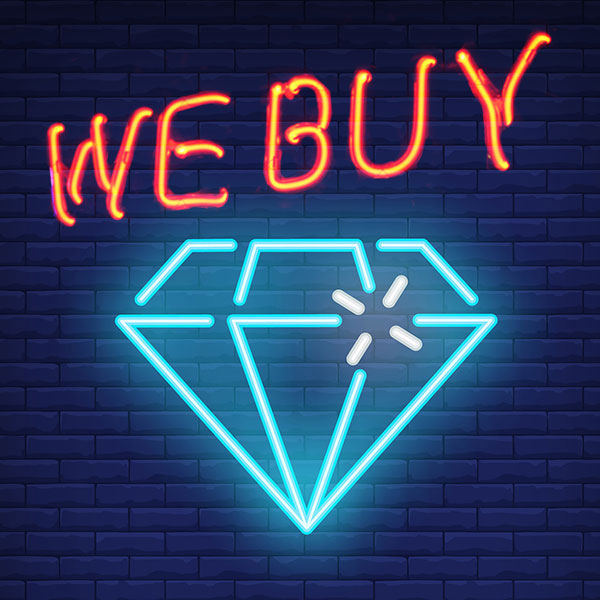
Last week, at the urging of a commenter, I looked into Kay’s and Jared’s policy for lab-grown diamond upgrades and trade-ins, now that both of those chains are selling them. Suffice it to say, it’s not the same as for naturals. Here’s Jared’s:
Our diamond trade-in and upgrade services allow you to take any diamond jewelry (excluding lab-created diamonds) you no longer wear and trade it in for a brand new one.
Kay’s site has similar language. And so does one of the biggest lab-grown diamond sellers online, Brilliant Earth.
Lab-grown manufacturer Diamond Foundry has traditionally touted its “forever 100% value guarantee”, which “guarantee[s] the value of your diamond forever” with a “free lifetime upgrade.” At press time, JCK could not find the guarantee still listed on its site. The company did not respond to requests for comment about the guarantee’s current status. (UPDATE: After this piece was posted, Diamond Foundry emailed it’s “still offering” the guarantee but the site “is focusing more on B2B sales right now so it is not currently listed.”)
This is a thorny issue for the lab-grown diamond world. Given that technology cheapens over time, and created-diamond production isn’t limited by nature, most believe that synthetic prices will drop. In fact, that process has already started, with prices falling over the last year despite a clear spike in demand. (Natural diamond prices have fallen recently, too, though not as much.) Last December, Diamond Foundry announced that it was setting its diamonds at 55% below the Rapaport list. A vendor just approached me on LinkedIn, promising prices 78%–89% below Rap.
Retail prices are falling, too. Analyst Paul Zimnisky estimates they have dropped an average of 20%–30% since the beginning of the year. In January, a 2.01 ct. J SI2 very good–cut lab-grown with an IGI report sold for $6,800 on Brilliant Earth. You can now see lab-growns with similar specs on the site in the $4,000 range.
Which may explain why some sellers are skittish about trade-ins. Though not all are.
Both Ada Diamonds and MiaDonna offer lab-grown upgrades, though they require the purchaser spend a certain price on the new stone—one and one-half times the original in Ada’s case and two times in MiaDonna’s. That isn’t unusual; many traditional sellers have similar policies.
And while it seems an exception, Wisconsin chain Kesslers Diamonds offers the same trade-in policy for lab-growns as it does for naturals—with no minimums.
If the approaches here seem all over the map, they point to a larger issue: Do lab-grown diamonds have resale value? Many in the mined world maintain they don’t.
There is a secondary market for lab diamonds, though it’s still a small one. (Which makes sense, as the category is still small.) Ada Diamonds has had a buyback program since May 2018. This year saw the launch of a somewhat-mysterious site, We Buy Lab Diamonds. And, of course, you can sell anything on eBay.
Ada founder and director of sales Lindsay Reinsmith says its buyback program serves three purposes. First, Ada specializes in high-color and -clarity lab-growns, and those remain hard to find. Two, like traditional jewelers, it gets better prices on second-hand diamonds. And finally, and more specific to the lab-grown market, it’s a “client benefit.”
“If you are guaranteed that you will receive a financial offer, that is peace of mind for a luxury clientele,” she says. “They know they won’t get a product with zero resale value.”
Of course, most don’t get full retail value for their trade-ins, but that’s also true of natural diamonds: “It’s a luxury purchase, like a Rolls-Royce,” Reinsmith says. “People have got to stop thinking this is a good place to park your money.”
For now, Ada’s buyback program is not a big part of its business.
“The product is fairly new and hasn’t been around a long time,” she says. “[Customers] haven’ t had a chance to get divorced yet.”
And like most jewelers, Reinsmith is selective about what she buys.
“We only buy what we are willing to sell,” she says. “We recently purchased a 2 ct. D VVS. That is something we will sell very quickly and we gave a good offer on it. If [consumers] have an ugly stone, they are going to struggle to sell it.”
Reinsmith admits that it’s not as easy to resell lab-growns as it is naturals, but she feels a market will eventually develop.
For the moment, though, most secondhand dealers are staying away, Paul Zimnisky found:
[M]ost of the prominent C2B (consumer-to-business) buyers of diamonds tend to only buy natural. For example, industry leaders WP Diamonds (White Pine), IIDV and Mondiamo, a Blue Nile partner, currently do not buy lab-created diamonds. Online player, Worthy.com, will buy lab-created diamonds, but only in solitaire sizes 2-carats or larger. I Do Now I Don’t (Delgatto) recently started “experimenting” with buying lab-created but noted that they will only buy at very discounted prices.
He thinks that a “robust [natural] diamond resale market for consumers is arguably one of the best ways for the industry to demonstrate the value of its product and also differentiate itself from not only lab-created diamonds, but from other competing luxury products.”
Yet it’s not clear whether customers will care or notice, given that these policies are usually relegated to fine print. Consumers tend to buy diamonds expecting they will be forever. And younger shoppers may feel it’s worth it to save a little money now, even if they could lose down the road.
Still, when I talk to jewelers reluctant to sell lab-growns, their number one reservation almost always revolves around value and how they’ll handle trade-ins and buybacks. For some now carrying them, the answer seems clear: They won’t.
(Photo illustration: Getty Images)
Follow JCK on Instagram: @jckmagazineFollow JCK on Twitter: @jckmagazine
Follow JCK on Facebook: @jckmagazine